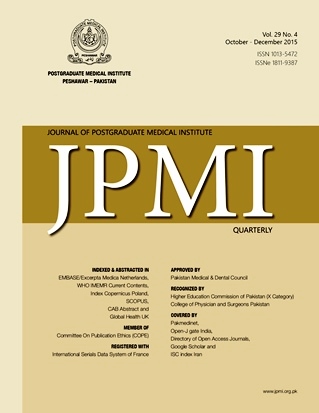HRCT LUNG FINDINGS IN POST CHEMOTHERAPY PATIENTS - EMERGING CHALLENGE FOR RADIOLOGISTS
Main Article Content
Abstract
Objective: To characterize, diagnose and to differentiate various HRCT mani -festations of lung abnormalities in post chemotherapy patients.
Methodology: This was a retrospective study of 50 patients conducted at Ra -diology department of Rehman Medical Institute, Peshawar. Duration of study
was 6months i.e from April 2013 to September 2013. Patients were investigat-ed using 128-slice Multidetector Computed tomography (MDCT) scanner in
the Radiology department of Rehman Medical Institute Peshawar.0.5mm re -constructed images in lung window and 3mm images in mediastinal window
were viewed on workstation in axial, coronal and sagittal planes. The data was
processed using Microsoft excel 2007.
Results: A total of 50 patients were included. Age of the patients ranged
from 6 to 70 years with a mean age of 35 years. In our study, we found five
radiologic patterns on CT scan; (1)non-specific ground-glass attenuation
17(34%),(2) patchy distribution of ground-glass attenuation accompanied
by interlobular septal thickening 7(14%), (3)multifocal areas of airspace con-solidation 7(14%),(4)extensive bilateral ground-glass attenuation or airspace
consolidations with traction bronchiectasis 4(8%), and (5) nodules of variable
sizes randomly distributed in both lungs 15(30%).
Conclusion: The most common pattern was found to be patchy areas of
ground-glass attenuation. Pulmonary diseases that are induced by chemo-therapy represent particular challenges for radiologists due to non-specific
and atypical imaging features.
Methodology: This was a retrospective study of 50 patients conducted at Ra -diology department of Rehman Medical Institute, Peshawar. Duration of study
was 6months i.e from April 2013 to September 2013. Patients were investigat-ed using 128-slice Multidetector Computed tomography (MDCT) scanner in
the Radiology department of Rehman Medical Institute Peshawar.0.5mm re -constructed images in lung window and 3mm images in mediastinal window
were viewed on workstation in axial, coronal and sagittal planes. The data was
processed using Microsoft excel 2007.
Results: A total of 50 patients were included. Age of the patients ranged
from 6 to 70 years with a mean age of 35 years. In our study, we found five
radiologic patterns on CT scan; (1)non-specific ground-glass attenuation
17(34%),(2) patchy distribution of ground-glass attenuation accompanied
by interlobular septal thickening 7(14%), (3)multifocal areas of airspace con-solidation 7(14%),(4)extensive bilateral ground-glass attenuation or airspace
consolidations with traction bronchiectasis 4(8%), and (5) nodules of variable
sizes randomly distributed in both lungs 15(30%).
Conclusion: The most common pattern was found to be patchy areas of
ground-glass attenuation. Pulmonary diseases that are induced by chemo-therapy represent particular challenges for radiologists due to non-specific
and atypical imaging features.
Article Details
How to Cite
1.
Siddique Umer U, Alam S, Ghaus SG, Gul S, Arif Q- ul- ain. HRCT LUNG FINDINGS IN POST CHEMOTHERAPY PATIENTS - EMERGING CHALLENGE FOR RADIOLOGISTS. J Postgrad Med Inst [Internet]. 2016 Jan. 3 [cited 2025 Dec. 5];29(4). Available from: https://jpmi.org.pk/index.php/jpmi/article/view/1718
Issue
Section
Original Article
Work published in JPMI is licensed under a
Creative Commons Attribution-NonCommercial 2.0 Generic License.
Authors are permitted and encouraged to post their work online (e.g., in institutional repositories or on their website) prior to and during the submission process, as it can lead to productive exchanges, as well as earlier and greater citation of published work.


